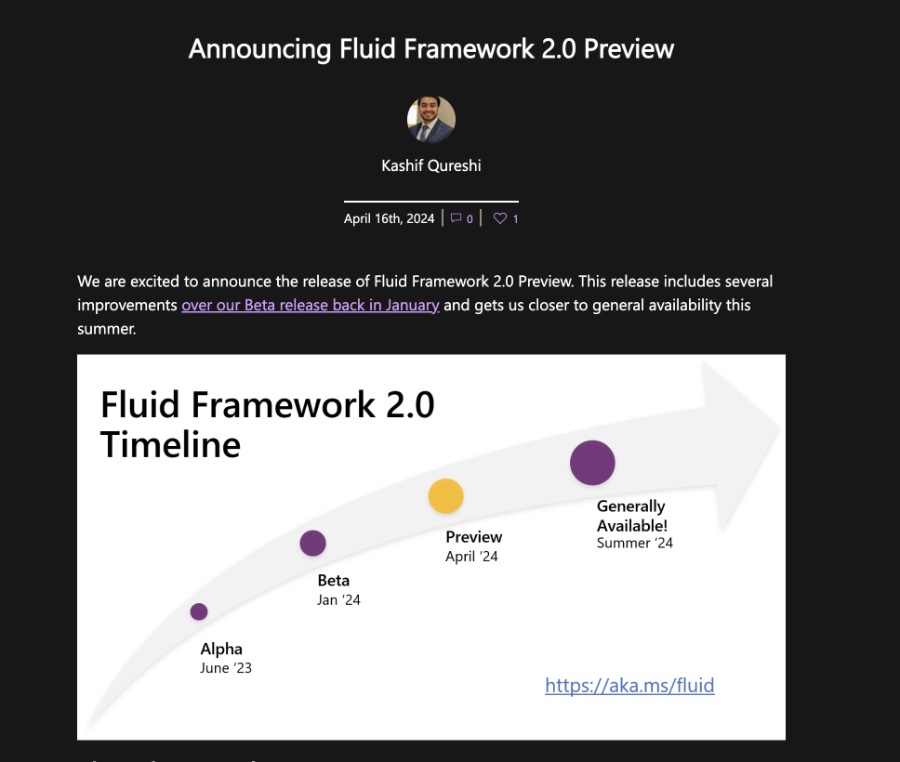
Explore the New Fluid Framework 2.0 Preview Launch
Explore Fluid Framework 2.0 Preview: Enhanced Collaboration, Undo/Redo, DevTools & More!
Key insights

- The Fluid Framework 2.0 Preview introduces substantial improvements over its Beta version, marking a step closer to the final release scheduled for this summer.
- A new feature named SharedTree Distributed Data Structure (DDS) simplifies programming with data support for a wide range of types, further enhanced with the ability to perform undo/redo operations on changes.
- Enhancements in transactions and events facilitate atomic application of multiple changes and creation of granular event listeners, respectively, improving the undo/redo capability.
- Schema improvements now support recursive types, enabling developers to define types with nodes that reference themselves, expanding the possibilities for data structuring.
- The launch also sees advancements in Fluid Developer Tools and typed telemetry support, aiming to enhance the development and monitoring of Fluid applications.
Exploring the Fluid Framework 2.0 Preview
The latest announcement from Microsoft introduces the Fluid Framework 2.0 Preview, a significant update that brings forward a plethora of enhancements designed to streamline the development experience and expand data management capabilities. At its core, the Fluid Framework seeks to provide developers with a flexible and intuitive platform for building collaborative and highly interactive web applications. With the introduction of the SharedTree Distributed Data Structure (DDS), developers now have access to a powerful tool that simplifies the handling of complex data types and facilitates real-time collaborative features. This update is pivotal in supporting a wide array of data types and offering capabilities such as undo/redo, atomic transactions, and event listeners, which are essential for creating dynamic and responsive applications.
- Undo/Redo – Added the ability to listen for changes and track revertible objects on your undo/redo stacks. Revertibles allow you to undo and redo changes even if other changes have been made in remote clients.
- Transactions – You can group multiple changes such that they are applied atomically, and if they fail, they fail atomically. As a result of grouping changes in a transaction, you also get a single revertible object making it easier to undo and redo.
- Events – We have updated the Events to make it easier to create granular event listeners for single nodes and better support the undo/redo feature.
- Schema improvements – Schemas are even more powerful now with the added support for recursive types, which allows you to define types that reference nodes of the same type in their subtree.
OTHER IMPROVEMENTS
We have also continued to make improvements to other parts of the release including:
- Developer Tools – Developer Tools is a browser extension that improves the developer experience when writing and debugging Fluid applications. It includes visualization of data stored in SharedTree and Ops latency telemetry visualization.
- Typed telemetry support – Before deploying your application at scale, it is critical to have the holistic telemetry in place to monitor its usage and look for issues and optimizations. Microsoft provides a fluid-telemetry package for this purpose.
- We have also added more samples and documentation to help you start building with SharePoint Embedded.
The framework’s commitment to improving developer tools is evident with upgrades to Fluid Developer Tools. These tools are designed to enhance the efficiency of writing and debugging Fluid applications by providing insights into data storage and performance metrics. Moreover, the inclusion of typed telemetry support is a testament to Microsoft’s focus on application monitoring and optimization. This feature allows for detailed tracking of app performance and user interactions, ensuring that developers have the necessary insights to refine their applications continuously.
As the Fluid Framework moves closer to its general availability, these advancements signal Microsoft's dedication to creating an environment where collaborative applications can thrive. Developers are encouraged to explore the Fluid Framework 2.0 Preview, experiment with its new features, and prepare for the upcoming general availability. The improvements highlighted in this preview are not just technical augmentations but steps toward a more interconnected and dynamic web development landscape.
Read the full article Announcing Fluid Framework 2.0 Preview

People also ask
What is the difference between SignalR and fluid framework?
Fluid Technology # Whereas SignalR primarily aims to streamline real-time communication between servers and clients, the Fluid Framework takes this a step further by abstracting that communication and, more importantly, focusing on the distribution of state across various clients.
What is a fluid framework?
The Fluid Framework comprises a series of client libraries designed for the distribution and synchronization of shared state. These libraries enable multiple clients to simultaneously create and manipulate shared data structures with coding patterns that are akin to handling local data.
Keywords
Fluid Framework 2.0, Fluid Framework Preview, Microsoft Fluid Framework, Collaborative Platform, Real-Time Collaboration Software, Fluid Framework Update, Interactive Content Creation, Seamless Collaboration Tool